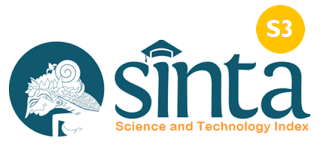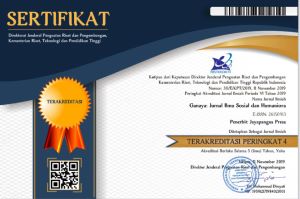Interactional Communication Between Teacher and Students to Improve the Quality of Learning At the Mutiara Hati Magelang Special School
DOI:
https://doi.org/10.37329/ganaya.v8i4.4809Keywords:
Interactional Communication, Learning Quality, Students with Special Needs, Special Needs SchoolsAbstract
This research is motivated by the importance of interactional communication in building effective relationships between teachers and students in Special Needs Schools (SLB), particularly at Mutiara Hati Special Needs School in Magelang. Unresponsive and one-way communication often becomes an obstacle in creating optimal learning quality for students with special needs, especially students who experience verbal barriers and social development disorders. In this context, this research aims to identify teacher interactional communication practices that can encourage increased student participation and motivation in learning. This research uses the interactional communication theory of Schramm and Budianto, which includes five leading indicators: response, openness, trust, empathy, and support. This study uses a descriptive qualitative approach with data collection methods through in-depth interviews, participant observation, and documentation. The primary informants consisted of three teachers at Mutiara Hati Special Needs School who had direct experience interacting with students with special needs. The study results indicate that interactional communication practices that prioritize empathy and openness, as well as adaptive verbal and nonverbal responses to the unique needs of each student, contribute significantly to increasing learning motivation, self-confidence, and learning quality. Teachers who demonstrate emotional understanding and use non-verbal approaches such as gentle facial expressions and light touch have been shown to create a more supportive and inclusive classroom climate. Effective interactional communication is a tool for conveying messages and a medium for building deep psychological connections between teachers and students. This study also recommends interactive communication training for special needs teachers as a sustainable strategy to improve the quality of inclusive education in Indonesia.
References
Ahmadi, S. H. (2023). Upaya Peningkatkan Kualitas Pembelajaran Melalui Persiapan Mengajar Guru. Jurnal Jendela Pendidikan, 3(1), 50-58.
Al-Munawarah, S. Z. (2024). Penerapan Model Komunikasi Schramm Pada Pembelajaran Teks Berita Kelas VII Di SMP Islam Bungoro. Titik Dua: Jurnal Pembelajaran Bahasa dan Sastra Indonesia, 4(2), 148-154.
Bachtiar, S. A. (2024). Effective Communication In Educational Supervision: Facilitating Collaboration and Improving Supervisory Quality. Journal Of Educational Administration, 18(1), 98-112.
Darmawan, D. F. (2021). Peranan Lingkungan Sekolah dan Kemampuan Berkomunikasi Guru Terhadap Motivasi Belajar Siswa. Jurnal Simki Pedagogia, 4(1), 11-23.
Erwan. (2020). Jurnal Ilmiah Pendidikan. Jurnal Ilmiah Pendidikan Citra Bakti, 6(2), 201-210.
Gainforth, H. L. (2014). The Role Of Interpersonal Communication In The Process Of Knowledge Mobilization Within A Community-Based Organization: A Network Analysis. Implementation Sci, 9(59), 1-8
Handayani, M. J. (2019). Model Komunikasi Guru dan Murid Di Sekolah Luar Biasa. Jurnal Riset Mahasiswa Dakwah dan Komunikasi, 1(2), 117-127.
Kaur, A. M. (2020). Investigating Students’ Experiences Of Students As Partners (SaP) For Basic Need Fulfilment: A Self-Determination Theory Perspective. Journal Of University Teaching and Learning Practice, 17(1), 1-17.
Kurniawati, A. B. (2023). Strategi Membangun Hubungan Positif Antara Guru dan Siswa Dalam Pembelajaran Inklusif. Jurnal Pendidikan dan Pembelajaran, 10(2), 123.
Littlejohn, S. W. (2016). Theories Of Human Communication: Eleventh Edition . Illinois: Waveland Press.
Marehan, R. (2020). The Role Of Interpersonal Communication Models In Enhancing Students Self-Confidence and Academic Performance. Educational Review, 22(1), 45-58.
Nurhasanah. (2022). Peningkatan Kualitas Pembelajaran Pendidikan Agama Islam Tentang Pernikahan Dalam Islam Melalui Model Think Pair Share (TPS) Berbasis CD Pembelajaran Pada Siswa Kelas XII SMA Negeri 4 Bangkalan Kabupaten Bangkalan. Jurnal Pendidikan Lampu, 8(1), 58-66.
Parawangsa, E., Hanani, T. N., Putra, M. R. S., Rostika, D., Sudarmansyah, R. (2024). Optimasi Komunikasi Guru-Siswa Di Sekolah Dasar Untuk Membangun Hubungan Positif Dalam Proses Pembelajaran. Journal Of Law Education and Business, 2(1), 722-728.
Permana, H. T. (2020). Pola Komunikasi Guru dan Murid Menggunakan Metode Pembelajaran Kelas Daring Di Kota Bandung. Kareba: Jurnal Ilmu Komunikasi, 9(1), 170-182.
Prikhodko, O. V., Cherdymova, E. I., Lopanova, E. V., Galchenko, N. A., Ikonnikov, A. I., Mechkovskaya, O. A., Karamova, O. V. (2020). Ways Of Expressing Emotions In Social Networks: Essential Features, Problems and Features Of Manifestation In Internet Communication. Online Journal of Communication and Media Technologies, 10(2), 1-7.
Pudjaningsih, W., Rustantono, H., Nurpeni, Budiyono, H., Hutabarat, Z. S., Nor, B., Taufan, A. (2023). The Influence Of School Environment and Teacher Communication On Economics Teacher Competence In Jambi Province. Al-Ishlah: Jurnal Pendidikan, 15(3), 3471-3479.
Rahmawati, R., Suryadi, Edi. (2019). Kreativitas Mengajar Guru dan Komunikasi Interaksional Sebagai Determinan Terhadap Prestasi Belajar Siswa. Jurnal Pendidikan Manajemen Perkantoran, 4(2), 190-199.
Sembiring, B., Masni, H., Rahim, A., Zahar, E., Hutabarat, Z. S., Tara, F., Agustina, R., Sujoko, Rahmawati, Andriani, L. (2024). Analysis Of The School Environment, Teacher Communication and Student Learning Motivation On The Influence Of Student Learning Outcomes. International Journal Of Multidisciplinary Science and Art, 3(3), 61-71.
Sutikno, M. Sobry. (2009). Pengelolaan Pendidikan Tinjauan Umum dan Konsep Islami. Bandung: Prospect.
Turner. (2009). Pengantar Teori Komunikasi Analisis dan Aplikasi. Jakarta: Salemba.
West, Richard L., Lynn H. Turner. (2006). Understanding Interpersonal Communication: Making Choices In Changing Times. Belmont, CA: Thomson/Wadsworth.
Yulia, Rahma, Sidharta. (2023). Model Komunikasi Kegiatan Remote Working. Jurnal Ilmu Komunikasi Andalan, 6(2), 145-154.
Downloads
Published
How to Cite
Issue
Section
License
Copyright (c) 2025 Arum Marwati, Safrina Jasmine, Widhihatmini Widhihatmini, Rahmat Rian Hidayat, Ardian Setio Utomo (Author)

This work is licensed under a Creative Commons Attribution-ShareAlike 4.0 International License.
An author who publishes in the Ganaya : Jurnal Ilmu Sosial dan Humaniora agrees to the following terms:
- Author retains the copyright and grants the journal the right of first publication of the work simultaneously licensed under the Creative Commons Attribution-ShareAlike 4.0 License that allows others to share the work with an acknowledgement of the work's authorship and initial publication in this journal
- Author is able to enter into separate, additional contractual arrangements for the non-exclusive distribution of the journal's published version of the work (e.g., post it to an institutional repository or publish it in a book) with the acknowledgement of its initial publication in this journal.
- Author is permitted and encouraged to post his/her work online (e.g., in institutional repositories or on their website) prior to and during the submission process, as it can lead to productive exchanges, as well as earlier and greater citation of the published work (See The Effect of Open Access).
Read more about the Creative Commons Attribution-ShareAlike 4.0 Licence here: https://creativecommons.org/licenses/by-sa/4.0/.








